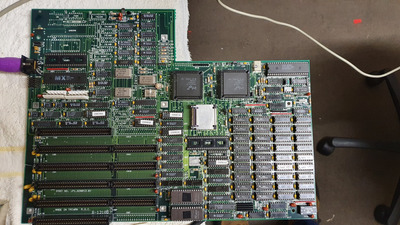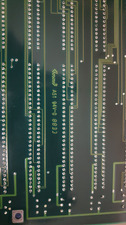Anonymous Coward wrote on 2020-07-24, 01:50:
I can't identify it, but it's pretty interesting...not just for the unusual shape, but also because it has an Intel chipset. I think it's really a Zymos chipset, but this is the first one I have ever seen one branded as "Intel" especially on a 286. The PCB quality looks good from the photos. Must have been an OEM board. If I had to guess, I'd say Acer. The part number looks similar.
OK, well the story behind this board is i rescued it from a computer recycler, I saw the case it came out of and it was a generic AT style case that most computers from the 80s were built in by your local computer store.
Certainly was not an Acer computer, but I do believe Acer did sell motherboards to OEM builders, much in the same way the likes of ASUS or Biostar, etc did.
As far as shape goes, ive seen a few 286 and even some 386 boards like this. The extra area seems to be used for an onboard serial port and floppy controller (this board has provision for the controller chips, but none of it is on this board) the serial ports are onboard with a IC socket for a UART, which is absent on this board.
It has an intel 10Mhz 286 on the board, as far as the intel chips go, I didnt realise that was uncommon on these, i had googled the chipset numbers and I did find an Intel datasheet for them, looking again just now, they seem to be made by other manufacturers, including Zymos as you say.
adalbert wrote on 2020-07-24, 01:53:
nzoomed wrote on 2020-07-24, 01:27:
I can't get it to post. My power supply won't even power up like normal, no fan
Maybe something is shorted on the motherboard and overcurrent protection in PSU kicks in, look for shorts to ground on power rails
Check the orientation of chips, are they rotated correctly (look for pin1 indication)
Thats what I was thinking too, definitely looks like a short of some sort.
Chips are definitely correct as far as sockets are, and also are installed in the same orientation they were before I removed them, I have a photo I took prior to removing them to verify their placement.
TheMobRules wrote on 2020-07-24, 02:01:
If the fan doesn't even start then it's the PSU protection kicking in, so you have a short somewhere (assuming the PSU is OK).
Almost certainly one of the tantalum caps is shorted.
Didnt think of checking the caps, I will go over them with a multimeter to see if any short. I never realised how unreliable those tantalum caps can be.
Horun wrote on 2020-07-24, 02:02:
Yes definately interesting ! It had an option for onboard Floppy controller (um8398) with its own BIOS (2764 64K EPROM). It does have at least one serial port thru the mx82c50. Yes an OEM for Acer makes a lot of sense. Going to be very hard to find any info on it as the docs for those type boards is almost totally long gone. I would use a DVM and check the PSU connectors and record the actual resistance measured to ground on each, as adalbert and TheMobRules says there probably is a short (a tantalum cap or two could be shorting just enough to trip the PSU.
Oh well, if i get it working i guess it doesnt matter in the end.
Hopefully if i get it working, I can get some info from its BIOS? Looks like its been reflashed at some point, its got black tape over the windows.
I know the PSU is OK, as ive been testing other boards with it.
Hopefully its just a tant thats gone.
Was more concerned about jumper settings if I need to make changes, like adding a 287, etc.

